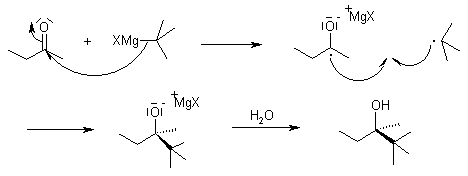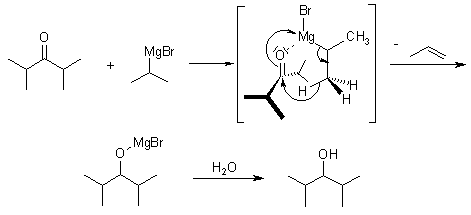Grignard Reagents
The Grignard Reaction is the addition of an organomagnesium halide (Grignard reagent) to a ketone or aldehyde, to form a tertiary or secondary alcohol, respectively. The reaction with formaldehyde leads to a primary alcohol.
Grignard Reagents are also used in the following important reactions: The addition of an excess of a Grignard reagent to an ester or lactone gives a tertiary alcohol in which two alkyl groups are the same, and the addition of a Grignard reagent to a nitrile produces an unsymmetrical ketone via a metalloimine intermediate. (Some more reactions are depicted below)
Mechanism of the Grignard Reaction
While the reaction is generally thought to proceed through a nucleophilic addition mechanism, sterically hindered substrates may react according to an SET (single electron transfer) mechanism:

With sterically hindered ketones the following side products are received:
The Grignard reagent can act as base, with deprotonation yielding an enolate intermediate. After work up, the starting ketone is recovered.

A reduction can also take place, in which a hydride is delivered from the β-carbon of the Grignard reagent to the carbonyl carbon via a cyclic six-membered transition state.

Additional reactions of Grignard Reagents:
With carboxylic acid chlorides:

Esters are less reactive than the intermediate ketones, therefore the reaction is only suitable for synthesis of tertiary alcohols using an excess of Grignard Reagent:

With nitriles:

With CO2 (by adding dry ice to the reaction mixture):

With oxiranes:

Recent Literature

Highly Enantioselective Desymmetrization of Anhydrides by Carbon Nucleophiles: Reaction of Grignard Reagents in the Presence of (-)-Sparteine
Zinc(II)-Catalyzed Addition of Grignard Reagents to Ketones

Three-Component Coupling Reactions of Thioformamides with Organolithium and Grignard Reagents Leading to Formation of Tertiary Amines and a Thiolating Agent

A highly efficient three-component coupling reaction between thioformamides and organolithium and Grignard reagents was developed. The generality of the process has been demonstrated by using various combinations of reactants and reagents.
T. Murai, F. Asai, J. Am. Chem. Soc., 2007, 129, 780-781.

Soluble Lanthanide Salts (LnCl3•2 LiCl) for the Improved Addition of Organomagnesium Reagents to Carbonyl Compounds

Highly Catalytic Asymmetric Addition of Deactivated Alkyl Grignard Reagents to Aldehydes
C.-S. Da, J.-R. Wang, X.-G. Yin, X.-Y. Fan, Y. Liu, S.-L. Yu, Org. Lett., 2009, 11, 5578-5581.

Sodium Methyl Carbonate as an Effective C1 Synthon. Synthesis of Carboxylic Acids, Benzophenones, and Unsymmetrical Ketones

The reaction of Grignard reagents with O-alkyl S-pyridin-2-yl thiocarbonates provides esters via chelation-stabilized intermediates.

Regioselective Halogen-Metal Exchange Reaction of 3-Substituted 1,2-Dibromo Arenes: The Synthesis of 2-Substituted 5-Bromobenzoic Acids
A LiCl-Mediated Br/Mg Exchange Reaction for the Preparation of Functionalized Aryl- and Heteroarylmagnesium Compounds from Organic Bromides

Highly Alkyl-Selective Addition to Ketones with Magnesium Ate Complexes Derived from Grignard Reagents

Conversion of Imines into C,N-Dimagnesiated Compounds and Trapping with Electrophiles. One-Pot Access to 1-Azaspirocyclic Framework

Addition of Grignard reagents to pyridine N-oxides in THF at room temperature and subsequent treatment with acetic anhydride at 120°C afforded 2-substituted pyridines in good yields. By exchanging acetic anhydride for DMF in the second step, 2-substituted pyridine N-oxides were obtained, enabling the synthesis of 2,6-disubstituted pyridines.







No comments:
Post a Comment